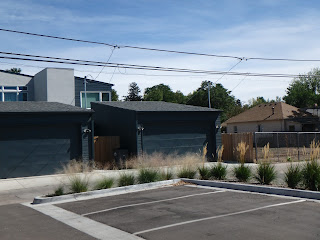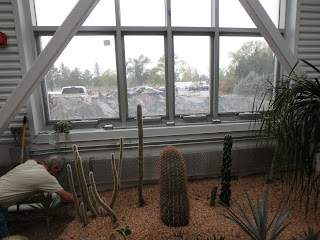I woke up in a botanical garden again; this time it's real.
I'm helping out Jeremy Schmidt here at Plant Delights/Juniper Level Botanic in Raleigh, North Carolina today.
He, with help from Michael Peden of New York, built several crevice garden beds this spring, which are already planted up with crazy things.
But these crevice garden are made with "Urbanite," or broken concrete. The brilliant gents at Utrecht Botanic have famously done this into spheres and diagonal walls, but there are few if any examples in the US.
So I'm here helping them get more of this bed finished before the NARGS AGM here November 17-19, where I thought I heard a rumour that our Panayoti will be helping Tony Avent peddle plants. Ought to be awesome; Don't be a sad fool like me and miss it!
So, what are we doing?
Jeremy and friends already started; so there is an established look, motifs, etcetera, that anything I do ought to compliment. I don't see my visit here as shoe-horning yet another ("my") style onto the grounds as much as seeing what they've started, and then extrapolate from that flavor to fill a larger, challenging area. Here's what PDN has done so far:

The first section are in divided beds on a corner.

Ooo, look, it's Agave montana in a crevice garden. I could faint with delight. You know, tons (most?) agaves are crevice plants out in the wild.
 Crevices aren't totally new at PDN- here, Bommeria hispida from AZ colonizing a drystacked sandstone wall gloriously.
Crevices aren't totally new at PDN- here, Bommeria hispida from AZ colonizing a drystacked sandstone wall gloriously.
Zach, their in-house taxonomist, says Teucrium polium was the plant whose surprising success seemed most due to life in a crevice.

The concrete color has already aged warmly since this spring when the first section went in..
So I landed here and am trying to absorb the spirit of this thing.
Concrete is not rock. It's funny, because none of us can help ourselves from calling it "rock" or "stone" as we work with it. But it isn't. All the cerebral and intuitive attitudes I have about placing stone is just baggage here. This is a garden which intends to be a garden- and as much as it may give a little nod to natural rock outcrops (in this case, Jeremy had the Canadian Shield in mind), it is only a nod, and cannot possible try to replicate or mimic rock, because it isn't. So we shouldn't.

Yes, it's a sculpture, an artifact, a garden installation. It's human-made.


So creating regular- two-by-four width spaced crevices is fair game. When starting my fanned/fluted section, I used two-by-four lumber's different dimensions to vary the crevices...
Props to Jeremy for the two-by-four idea.

Some of the native beach sand soil we are cutting into is madly beautiful.
Instead of fossils, there are rusty shadows of wire reinforcements. There is no strata, just the relentless one-flat-sided nature of concrete which was once one big flat thing. So you shouldn't fight that to fake a mountain. I believe.

That's also why it doesn't bother me at all that the cold dark gray Permatil (expanded shale) de facto topdressing absolutely contrasts to the warm white- gray concrete. Especially when there are Mammillaria plumosa. (Yeah, that's a total gambit)
So this crevice garden must honor its material, which is the broken up foundation of an old razed barn. At its core it is doing something great- cultivating rare plants- with something nasty- human leftover waste-materials. It a little Tyler Durden, a little Hugelkultur, and totally contrived. And we're running with it.
Coming to you, from a place totally infested with Agave ovatifolia. Collect them all.















































